#medieval british history
Explore tagged Tumblr posts
Text
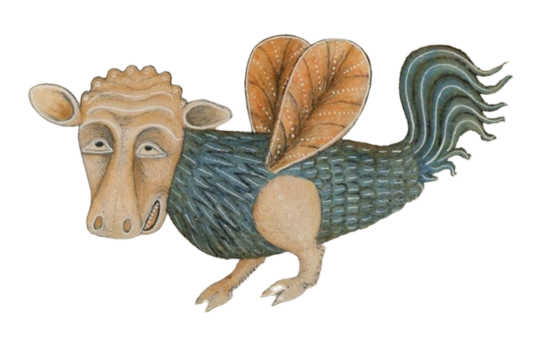
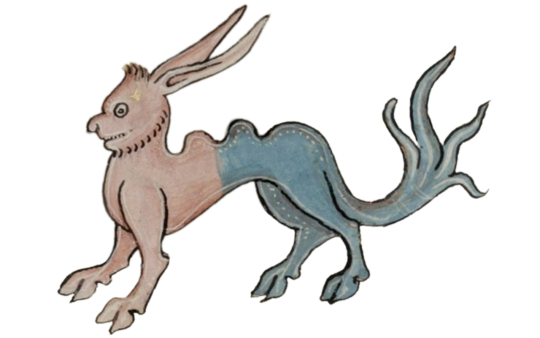
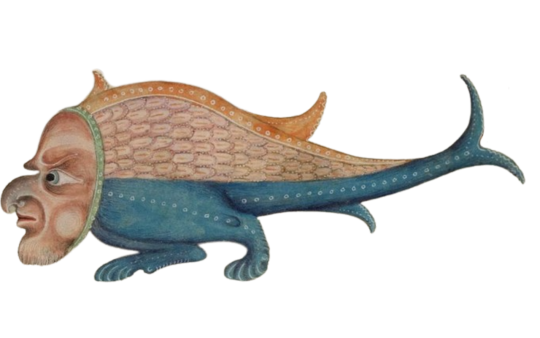
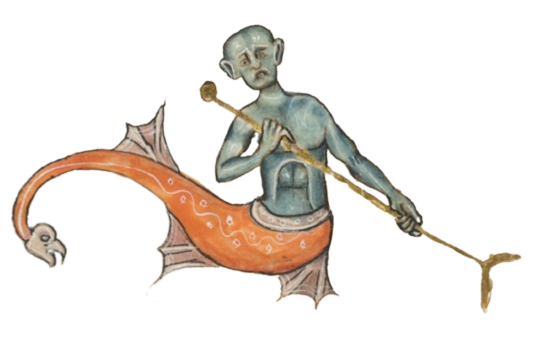

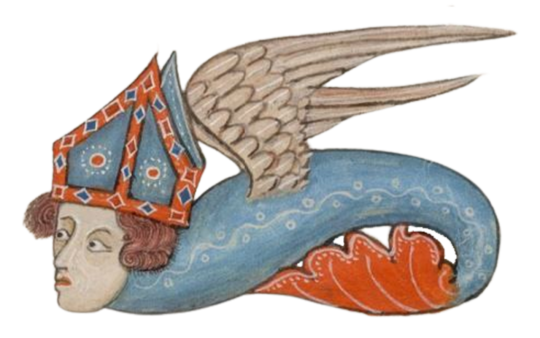
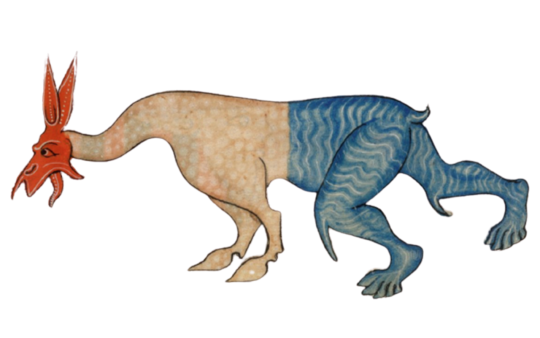
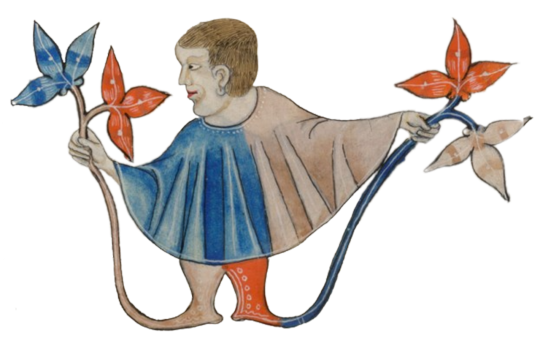
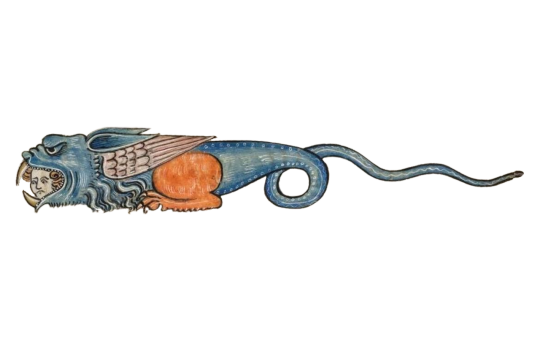
Creatures from the Luttrell Psalter (c. 1320-1340) PNGs, part 1.
(Source)
#png#pngs#transparent#sticker#stickers#moodboard#artboard#collage#imageboard#historical#medieval#art#art history#1300s#british library#public domain
5K notes
·
View notes
Text

Title: The Fairy Wood Artist: Henry Meynell Rheam (English, 1859-1920) Date: 1903 Genre: fantasy art; medievalism Medium: pencil and watercolor on paper Dimensions: 72.1 cm (28.3 in) high x 77.2 cm (30.3 in) wide Location: private collection
#art#art history#Henry Meynell Rheam#fantasy#fantasy art#medievalism#fairy#fairies#fair folk#British art#English art#20th century art#watercolor#watercolor on paper#private collection
580 notes
·
View notes
Text

Awaiting his return by William Henry Margetson
#william henry margetson#art#middle ages#medieval#mediaeval#shield#shields#heraldry#romantic#romanticism#chivalry#history#europe#european#knights#knight#maiden#damsel#nobility#woman#lady#arthurian#british#britain#english#england
846 notes
·
View notes
Text


Hand-and-a-Half Sword, European, possibly British, 15th Century
From the Met Museum
541 notes
·
View notes
Text
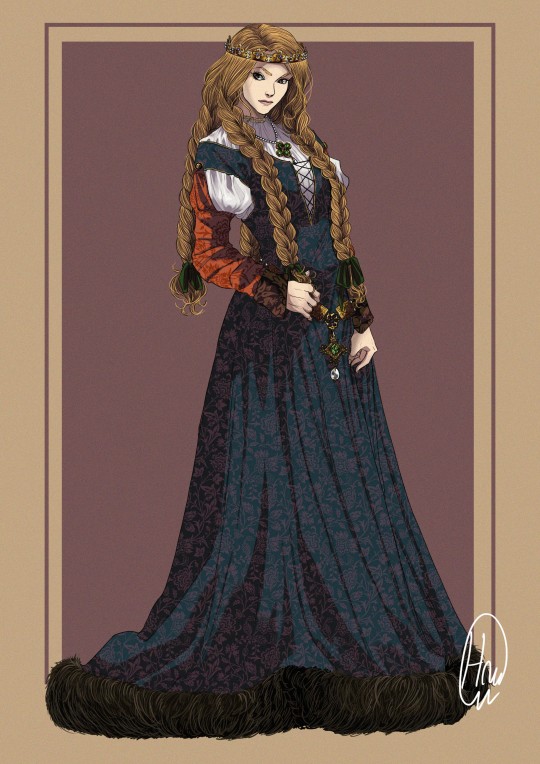
Elizabeth of York, fashion character design, c. 1479.
#the wars of the roses#15th century#medieval#middle ages#historical#british history#medieval england#art#illustration#sketch#edward iv#elizabeth woodville#elizabeth of york#henry vii#henry vi#margaret beaufort#richard iii#the white queen#the white princess#medieval fashion#character design#fanart#oc art#my art#artists on tumblr#medieval costume#house of york#plantagenets
362 notes
·
View notes
Text
292 notes
·
View notes
Text
"This woman, nicknamed ‘Piper’ by the University of Central Lancashire archaeologists who uncovered her in 2014, was buried in grave 116 in a sixth-century early medieval cemetery in Oakington, Cambridge. More interesting than the pipe, which was a pure accident of directional drilling, her grave was richly furnished. She had a brooch on each shoulder, wrist-clasps, and a large ornate cruciform brooch, indicating she had been buried in a peplos dress over a long-sleeved dress and wrapped in a pinned cloak. She also had a collection of glass and amber beads. These items in her grave indicate that she was a wealthy and important woman within her community at Oakington.
The more I researched this dig, which was overseen by archaeologists Dr Faye Simpson and Dr Duncan Sayer, the more the site was revealed to be a remarkable insight into early medieval gender and society. Piper was not the only high-status woman in the Oakington cemetery. In fact, there were a large number of furnished female burials, which acted as focal points throughout the cemetery, and very few male ones.
Duncan Sayer has called the Oakington dig suggestive of a ‘female-dominated matriarchal group’ in early medieval England. What’s more, around thirty percent of the 124 graves were those of infants. The high number of infant burials is disproportionate, indicating that women were in this area specifically to give birth within this matriarchal community.
During the past week there has been much excitement on social media and in the press about the findings of a recent DNA study, which provide evidence for matrilocal societies in Iron Age Dorset. Matrilocal societies are groups in which women stay within family groups, marrying outsiders, while male family members join different groups. Such societies would naturally revolve around generations of women. The Oakington site might provide a comparable example, though centuries later, of a similar kind of female-dominated group."
#history#women in history#women's history#6th century#english history#england#british history#early middle ages#middle ages#medieval women#medieval history
115 notes
·
View notes
Text

Lincoln Cathedral 🏴🇬🇧
#🇬🇧#🏴#lincoln cathedral#Lincoln#lincolnshire#stained glass window#stained glass#stain glass#stain glass window#anglican#anglicanism#c of e#church of england#medieval#medieval church#English history#British history#uk#gb#England#united kingdom#Great Britain#christianity#Christian#church#cathedral#church window
75 notes
·
View notes
Text
Did the ancient Celts really paint themselves blue?
Part 2: Irish tattoos



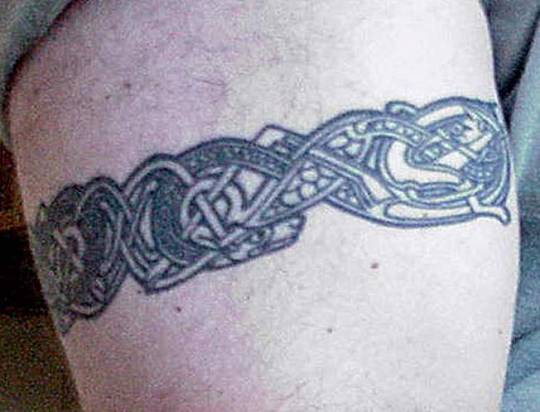
Clockwise from top left: Deirdre and Naoise from the Ulster Cycle by amylouioc, detail from The Marriage of Strongbow and Aoife by Daniel Maclise, a modern Celtic revival tattoo, Michael Flatley in a promotional image for the Irish step dance show 'Lord of the Dance'
This is my second post exploring the historical evidence for our modern belief that the ancient and medieval Insular Celts painted or tattooed themselves with blue pigment. In the first post, I discussed the fact that body paint seems to have been used by residents of Great Britain between approximately 50 BCE to 100 CE. In this post, I will examine the evidence for tattooing.
Once again, I am looking at sources pertaining to any ethnic group who lived in the British Isles, this time from the Roman Era to the early Middle Ages. The relevant text sources range from approximately 200 CE to 900 CE. I am including all British Isles cultures, because a) determining exactly which Insular culture various writers mean by terms like ‘Briton’, ‘Scot’, and ‘Pict’ is sometimes impossible and b) I don’t want to risk excluding any relevant evidence.
Continental Written Sources:
The earliest written source to mention tattoos in the British Isles is Herodian of Antioch’s History of the Roman Empire written circa 208 CE. In it, Herodian says of the Britons, "They tattoo their bodies with colored designs and drawings of all kinds of animals; for this reason they do not wear clothes, which would conceal the decorations on their bodies" (translation from MacQuarrie 1997). Herodian is probably reporting second-hand information given to him by soldiers who fought under Septimius Severus in Britain (MacQuarrie 1997) and shouldn't be considered a true primary source.
Also in the early 3rd century, Gaius Julius Solinus says in Collectanea Rerum Memorabilium 22.12, "regionem [Brittaniae] partim tenent barbari, quibus per artifices plagarum figuras iam inde a pueris variae animalium effigies incorporantur, inscriptisque visceribus hominis incremento pigmenti notae crescunt: nec quicquam mage patientiae loco nationes ferae ducunt, quam ut per memores cicatrices plurimum fuci artus bibant."
Translation: "The area [of Britain] is partly occupied by barbarians on whose bodies, from their childhood upwards, various forms of living creatures are represented by means of cunningly wrought marks: and when the flesh of the person has been deeply branded, then the marks of the pigment get larger as the man grows, and the barbaric nations regard it as the highest pitch of endurance to allow their limbs to drink in as much of the dye as possible through the scars which record this" (from MacQuarrie 1997).
This passage, like Herodian's, is clearly a description of tattooing, not body staining or painting. That said, I have no idea of tattoos actually work like this. I would think this would result in the adult having a faded, indistinct tattoo, but if anyone knows otherwise, please tell me.
The poet Claudian, writing in the early 5th c., is the first to specifically mention the Picts having tattoos (MacQuarrie 1997). In De Bello Gothico he says, "Venit & extremis legio praetenta Britannis,/ Quæ Scoto dat frena truci, ferroque notatas/ Perlegit exanimes Picto moriente figuras."
Translation: "The legion comes to make a trial of the most remote parts of Britain where it subdues the wild Scot and gazes on the iron-wrought figures on the face of the dying Pict" (from MacQuarrie 1997).
Last, and possibly least, of our Mediterranean sources is Isidore of Seville. In the early 7th c. he writes, "the Pictish race, their name derived from their body, which the efficient needle, with minute punctures, rubs in the juices squeezed from native plants so that it may bring these scars to its own fashion [. . .] The Scotti have their name from their own language by reason of [their] painted body, because they are marked by iron needles with dark coloring in the form of a marking of varying shapes." (translation from MacQuarrie 1997)
Isidore is the earliest writer to explicitly link the name 'Pict' to their 'painted' (Latin: pictus) i.e. tattooed bodies. Isidore probably borrowed information for his description from earlier writers like Claudian (MacQuarrie 1997).
In the 8th century, we have a source that definitely isn't Romans recycling old hearsay. In 786, a pair of papal legates visited the Anglo-Saxon kingdoms of Mercia and Northumbria (Story 1995). In their report to Pope Hadrian, the legates condemn pagans who have "superimposed most hideous cicatrices" (i.e gotten tattoos), likening the pagan practice to coloring oneself "with dirty spots". The location of the visit indicates that these are Anglo-Saxon tattoos rather than Celtic, but some scholars have suggested that the Anglo-Saxons might have adopted the practice from the Brittonic Celts (MacQuarrie 1997).
A gloss in the margin of the late 9th c. German manuscript Fulda Aa 2 defines Stingmata [sic] as "put pictures on the bodies as the Irish (Scotti) do." (translation from MacQuarrie 1997).
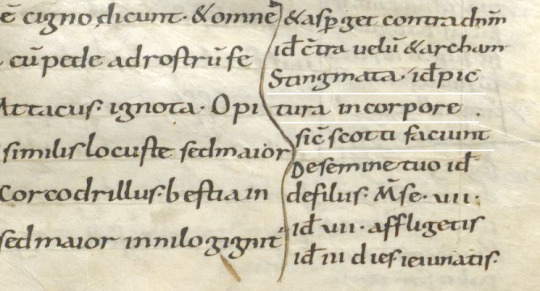
Fulda Aa 2 folio 43r The gloss is on the left underlined in white.
Irish Written Sources:
Irish texts that mention tattoos date to approximately 700-900 CE, although some of them have glosses that may be slightly later, and some of them cannot be precisely dated.
The first text source is a poem known in English as "The Caldron of Poesy," written in the early 8th c. (Breatnach 1981). The poem is purportedly the work of Amairgen, ollamh of the legendary Milesian kings. In the first stanza of the poem, he introduces himself saying, "I being white-kneed, blue-shanked, grey-bearded Amairgen." (translation from Breatnach 1981)
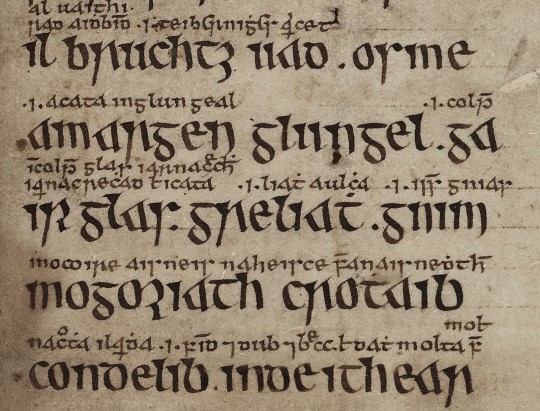
The text of the poem with interline glosses from Trinity College Dublin MS 1337/1
The word garrglas (blue-shanked) has a Middle Irish (c. 900-1200) gloss added by a later scribe, defining garrglas as: "a tattooed shank, or who has the blue tattooed shank" (Breatnach 1981).
Although Amairgen was a mythical figure, the position ollamh was not. An ollamh was the highest rank of poet in medieval Ireland, considered worthy of the same honor-price as a king (Carey 1997, Breatnach 1981). The fact that a man of such esteemed status introduces himself with the descriptor 'blue-shanked' suggests that tattoos were a respectable thing to have in early medieval Ireland.
The leg tattoos are also mentioned c. 900 CE in Cormac’s Glossary. It defines feirenn as "a thong which is about the calf of a man whence ‘a tattooed thong is tattooed about [the] calf’" (translation from MacQuarrie 1997)
The Irish legal text Uraicecht Becc, dated to the 9th or early 10th c., includes the word creccoire on a list of low-status occupations (Szacillo 2012, MacNeill 1924). A gloss defines it as: crechad glass ar na roscaib, a phrase which Szacillo interprets as meaning "making grey-blue sore (tattooing) on the eyes" (2012). This sounds rather strange, but another early Irish text clarifies it.
The Vita sancti Colmani abbatis de Land Elo written around the 8th-9th centuries (Szacillo 2012) contains the following episode:
On another time, St Colmán, looking upon his brother, who was the son of Beugne, saw that the lids of his eyes had been secretly painted with the hyacinth colour, as it was in the custom; and it was a great offence at St Colmán’s. He said to his brother: ‘May your eyes not see the light in your life (any more). And from that hour he was blind, seeing nothing until (his) death. (translation from Szacillo 2012).
The original Latin phrase describing what so offended St Colmán "palpebre oculorum illius latenter iacinto colore" does not contain the verb paint (pingo). It just says his eyelids were hyacinth (blue) colored. This passage together with the gloss from the Uraicecht Becc implies that there was a custom of tattooing people's eyelids blue in early medieval Ireland. A creccoire* was therefore a professional eyelid tattooer or a tattoo artist.
A possible third reference to tattooing the area around the eye is found in a list of Old Irish kennings. The kenning for the letter 'B' translates as 'Beauty of the eyebrow.' This kenning is glossed with the word crecad/creccad (McManus 1988). Crecad could be translated as cauterizing, branding, or tattooing (eDIL). McManus suggests "adornment (by tattooing) of the eyebrow" as a plausible interpretation of how crecad relates to the beauty of the eyebrow (1988). The precise date of this text is not known (McManus 1988), but Old Irish was used c. 600-900 CE, meaning this text is of a similar date to the other Irish references to tattoos.
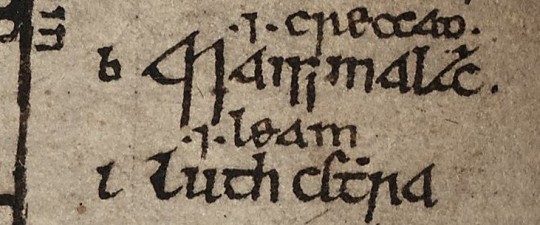
Kenning of the letter 'b' with gloss from TCD MS 1337/1
There is a sharp contrast between the association of tattoos with a venerated figure in 'The Caldron of Poesy', and their association with low-status work and divine punishment in the Uraicecht Becc and the Vita. This indicates that there was a shift in the cultural attitude towards tattoos in Ireland during the 7th-9th centuries. The fact that a Christian saint considered getting tattoos a big enough offense to punish his own brother with blindness suggests that tattooing might have been a pagan practice which gradually got pushed out by the Catholic Church. This timeline is consistent with the 786 CE report of the papal legates condemning the pagan practice of tattooing in Great Britain (MacQuarrie 1997).
There are some mentions of tattooing in Lebor Gabála Érenn, but the information largely appears to be borrowed from Isidore of Seville (MacQuarrie 1997). The fact that the writers of LGE just regurgitated Isidore's meager descriptions of Pictish and Scottish (ie Irish) tattooing without adding any details, such as the designs used or which parts of the body were tattooed, makes me think that Insular tattooing practices had passed out of living memory by the time the book was written in the 11th century.
*There is some etymological controversy over this term. Some have suggested that the Old Irish word for eyelid-tattooer should actually be crechaire. more info Even if this hypothesis is correct, and the scribe who wrote the gloss on creccoire mistook it for crechaire, this doesn't contradict my argument. The scribe clearly believed that eyelid-tattooer belonged on a list of low-status occupations.
Discussion:
Like Julius Cesar in the last post, Herodian of Antioch c. 208 CE makes some dubious claims of Celtic barbarism, stating that the Britons were: "Strangers to clothing, the Britons wear ornaments of iron at their waists and throats; considering iron a symbol of wealth, they value this metal as other barbarians value gold" (translation from MacQuarrie 1997). If the Britons wore nothing but iron jewelry, then why did they have brass torcs and 5,000 objects that look like they're meant to attach to fabric, Herodian?
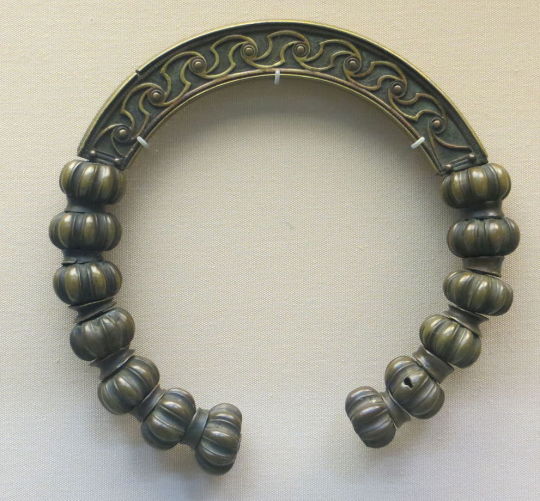
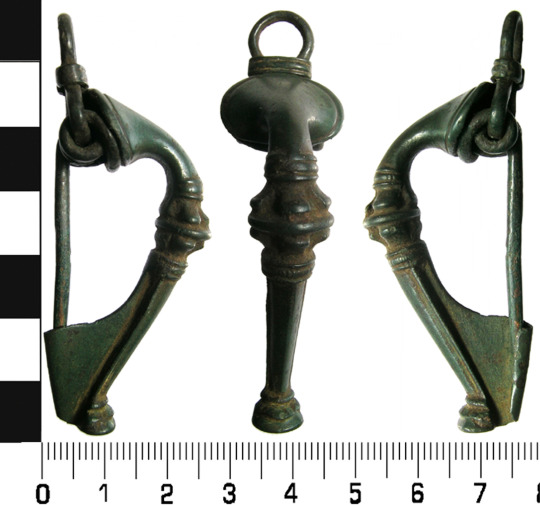
Brass torc from Lochar Moss, Scotland c. 50-200 CE. Romano-British trumpet brooch from Cumbria c. 75-175 CE. image from the Portable Antiquities Scheme.
Trumpet brooches are a Roman Era artifact invented in Britain, that were probably pinned to people's clothing. more info
Although Herodian and Solinus both make dubious claims, there are enough differences between them to indicate that they had 2 separate sources of information, and one was not just parroting the other. This combined with the fact that we have more-reliable sources from later centuries confirming the existence of tattoos in the British Isles makes it probable that there was at least a grain of truth to their claims of tattooing.
There is a common belief that the name Pict originated from the Latin pictus (painted), because the Picts had 'painted' or tattooed bodies. The Romans first used the name Pict to refer to inhabitants of Britain in 297 CE (Ware 2021), but the first mention of Pictish tattoos came in 402 CE (Carr 2005), and the first explicit statement that the name Pict was derived from the Picts' tattooed bodies came from Isidore of Seville c. 600 CE (MacQuarrie 1997). Unless someone can find an earlier source for this alleged etymology than Isidore, I am extremely skeptical of it.
Summary of the written evidence:
Some time between c. 79 CE (Pliny the Elder) and c. 208 CE (Herodian of Antioch) the practice of body art in Great Britain changed from staining or painting the skin to tattooing. Third century Celtic Briton tattoo designs depicted animals. Pictish tattoos are first mentioned in the 5th century.
The earliest mention of Irish tattoos comes from Isidore of Seville in the early 6th c., but since it seems to have been a pre-Christian practice, it likely started earlier. Irish tattoos of the 8-9th centuries were placed on the area around the eye and on the legs. They were a bluish color. The 8th c. Anglo-Saxons also had tattoos.
Tattooing in Ireland probably ended by the early 10th c., possibly because of Christian condemnation. Exactly when tattooing ended in Great Britain is unclear, but in the 12th c., William of Malmesbury describes it as a thing of the past (MacQuarrie 1997). None of these sources give much detail as to what the tattoos looked like.
The Archaeology of Insular Ink:
In spite of the fact that tattooing was a longer-lasting, more wide-spread practice in the British Isles than body painting, there is less archaeological evidence for it. This may be because the common tools used for tattooing, needles or blades for puncturing the skin, pigments to make the ink, and dishes to hold the ink, all had other common uses in the Middle Ages that could make an archaeologist overlook their use in tattooing. The same needle that was used to sew a tunic could also have been used to tattoo a leg (Carr 2005). A group of small, toothed bronze plates from a Romano-British site at Chalton, Hampshire might have been tattoo chisels (Carr 2005) or they might have been used to make stitching holes in leather (Cunliffe 1977).
Although the pigment used to make tattoos may be difficult to identify at archaeological sites, other lines of evidence might give us an idea of what it was. Although the written sources tell us that Irish tattoos were blue, the popular modern belief that woad was the source of the tattoo pigment is, in my opinion, extremely unlikely for a couple of reasons:
1) Blue pigment from woad doesn't seem to work as tattoo ink. The modern tattoo artists who have tried to use it have found that it burns out of the person's skin, leaving a scar with no trace of blue in it (Lambert 2004).
2) None of the historical sources actually mention tattooing with woad. Julius Cesar and Pliny the Elder mention something that might have been woad, but they were talking about body paint, not tattoos. (see previous post) Isidore of Seville claimed that the Picts were tattooing themselves with "juices squeezed from native plants", but even assuming that Isidore is a reliable source, you can't get blue from woad by just squeezing the juice out of it. In order to get blue out of woad, you have to first steep the leaves, then discard the leaves and add a base like ammonia to the vat (Carr 2005). The resulting dye vat is not something any knowledgeable person would describe as plant juice, so either Isidore had no idea what he was talking about, or he is talking about something other than blue pigment from woad.
In my opinion, the most likely pigment for early Irish and British tattoos is charcoal. Early tattoos found on mummies from Europe and Siberia all contain charcoal and no other colored pigment. These tattoos range in date from c. 3300 BCE (Ötzi the Iceman) to c. 300 CE (Oglakhty grave 4) (Samadelli et al 2015, Pankova 2013).
Despite the fact that charcoal is black, it tends to look blueish when used in tattoos (Pankova 2013). Even modern black ink tattoos that use carbon black pigment (which is effectively a purer form of charcoal) tend to look increasingly blue as they age.
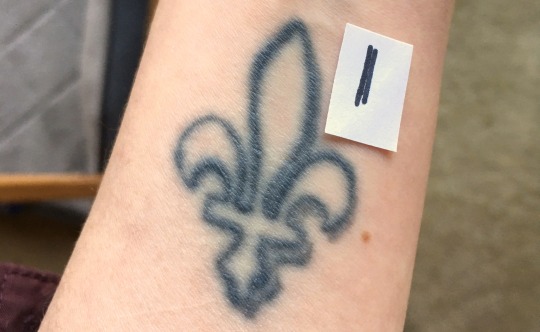
A 17-year-old tattoo in carbon black ink photographed with a swatch of black Sharpie on white printer paper.
The fact that charcoal-based tattoo inks continue to be used today, more than 5,000 years after the first charcoal tattoo was given, shows that charcoal is an effective, relatively safe tattoo pigment, unlike woad. Additionally, charcoal can be easily produced with wood fires, meaning it would have been a readily available material for tattoo artists in the early medieval British Isles. We would need more direct evidence, like a tattooed body from the British Isles, to confirm its use though.
As of June 2024, there have been at least 279 bog bodies* found in the British Isles (Ó Floinn 1995, Turner 1995, Cowie, Picken, Wallace 2011, Giles 2020, BBC 2024), a handful of which have made it into modern museum collections. Unfortunately, tattoos have not been found on any of them. (We don't have a full scientific analysis for the 2023 Bellaghy find yet though.)
*This number includes some finds from fens. It does not include the Cladh Hallan composite mummies.
Tattoos in period art?
It has been suggested that the man fight a beast on Book of Kells f. 130r may be naked and covered in tattoos (MacQuarrie 1997). However, Dress in Ireland author Mairead Dunlevy interprets this illustration as a man wearing a jacket and trews (Dunlevy 1989). Looking at some of the other figures in the Book of Kells, I agree with Dunlevy. F. 97v shows the same long, fitted sleeves and round neckline. F. 292r has long, fitted leg coverings, presumably trews, and also long sleeves. The interlace and dot motifs on f. 130r's legs may be embroidery. Embroidered garments were a status symbol in early medieval Ireland (Dunlevy 1989).

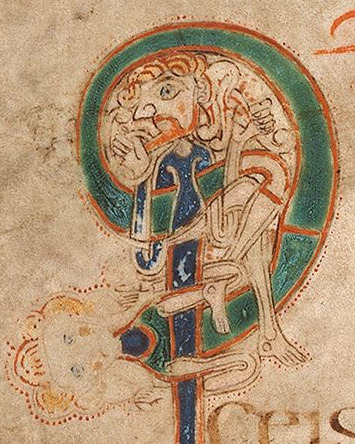

Left to right: Book of Kells folios 130r, 97v, 292r
A couple of sculptures in County Fermanagh might sport depictions of Irish tattoos. The first, known as the Bishop stone, is in the Killadeas cemetery. It features a carved head with 2 marks on the left side of the face, a double line beside the mouth and a single line below the eye. These lines may represent tattoos.
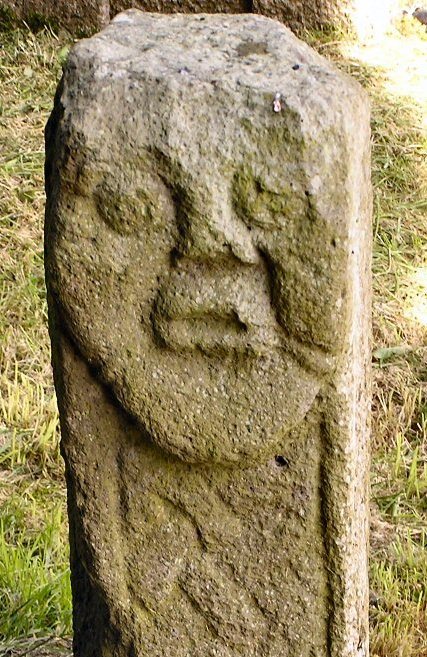
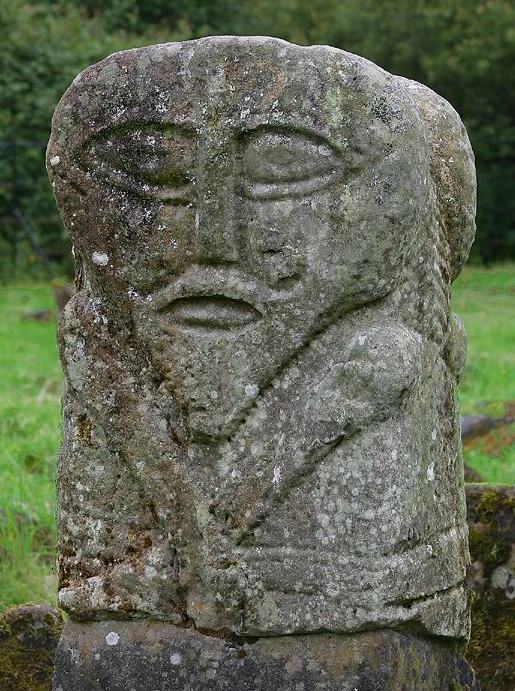
The second sculpture is the Janus figure on Boa Island. (So named because it has 2 faces; it's not Roman.) It has marks under the right eye and extending from the corner of the left eye that may be tattoos.
I cannot find a definitive date for the Bishop stone head, but it bears a strong resemblance to the nearby White Island church figures. The White Island figures are stylistically dated to the 9th-10th centuries and may come from a church that was destroyed by Vikings in 837 CE (Halpin and Newman 2006, Lowry-Corry 1959). The Janus figure is believed to be Iron Age or early medieval (Halpin and Newman 2006).
Conclusions:
Despite the fact that tattooing as a custom in the British Isles lasted for more than 500 years and was practiced by at least 3 different cultures, written sources remain our only solid evidence for it. With only a dozen sources, some of which probably copied each other, to cover this time span, there are huge gaps in our knowledge. The 4th century Picts may not have had the same tattoo designs, placements or reasons for getting tattooed as the 8th c. Irish or Anglo-Saxons. These sources only give us fragments of information on who got tattooed, where the tattoos were placed, what they looked like, how the tattoos were done, and why people got tattooed. Further complicating our limited information is the fact that most of the text sources come from foreigners and/or people who were prejudiced against tattooing, which calls their accuracy into question.
'The Cauldron of Posey' is one source that provides some detail while not showing prejudice against tattoos. The author of the poem was probably Christian, but the poem appears to have been written at a time when Pagan practices were still tolerated in Ireland. I have a complete translation of the poem along with a longer discussion of religious elements here.
Leave me a tip?
Bibliography:
BBC (2024). Bellaghy bog body: Human remains are 2,000 years old https://www.bbc.com/news/uk-northern-ireland-68092307
Breatnach, L. (1981). The Cauldron of Poesy. Ériu, 32(1981), 45-93. https://www.jstor.org/stable/30007454
Carey, J. (1997). The Three Things Required of a Poet. Ériu, 48(1997), 41-58. https://www.jstor.org/stable/30007956
Carr, Gillian. (2005). Woad, Tattooing and Identity in Later Iron Age and Early Roman Britain. Oxford Journal of Archaeology 24(3), 273–292. https://doi.org/10.1111/j.1468-0092.2005.00236.x
Cowie, T., Pickin, J. and Wallace, T. (2011). Bog bodies from Scotland: old finds, new records. Journal of Wetland Archaeology 10(1): 1–45.
Cunliffe, B. (1977) The Romano-British Village at Chalton, Hants. Proceedings of the Hampshire Field Club and Archaeological Society, 33(1977), 45-67.
Dunlevy, Mairead (1989). Dress in Ireland. B. T. Batsford LTD, London.
eDIL s.v. crechad https://dil.ie/12794
Giles, Melanie. (2020). Bog Bodies Face to face with the past. Manchester University Press, Manchester. https://library.oapen.org/viewer/web/viewer.html?file=/bitstream/handle/20.500.12657/46717/9781526150196_fullhl.pdf?sequence=1&isAllowed=y
Halpin, A., Newman, C. (2006). Ireland: An Oxford Archaeological Guide to Sites from Earliest Times to AD 1600. Oxford University Press, Oxford. https://archive.org/details/irelandoxfordarc0000halp/page/n3/mode/2up
Hoecherl, M. (2016). Controlling Colours: Function and Meaning of Colour in the British Iron Age. Archaeopress Publishing LTD, Oxford. https://www.google.com/books/edition/Controlling_Colours/WRteEAAAQBAJ?hl=en&gbpv=0
Lambert, S. K. (2004). The Problem of the Woad. Dunsgathan.net. https://dunsgathan.net/essays/woad.htm
Lowry-Corry, D. (1959). A Newly Discovered Statue at the Church on White Island, County Fermanagh. Ulster Journal of Archaeology, 22(1959), 59-66. https://www.jstor.org/stable/20567530
MacQuarrie, Charles. (1997). Insular Celtic tattooing: History, myth and metaphor. Etudes Celtiques, 33, 159-189. https://doi.org/10.3406/ecelt.1997.2117
McManus, D. (1988). Irish Letter-Names and Their Kennings. Ériu, 39(1988), 127-168. https://www.jstor.org/stable/30024135
Ó Floinn, R. (1995). Recent research into Irish bog bodies. In R. C. Turner and R. G. Scaife (eds) Bog Bodies: New Discoveries and New Perspectives (p. 137–45). British Museum Press, London. ISBN: 9780714123059
Pankova, S. (2013). One More Culture with Ancient Tattoo Tradition in Southern Siberia: Tattoos on a Mummy from the Oglakhty Burial Ground, 3rd-4th century AD. Zurich Studies in Archaeology, 9(2013), 75-86.
Samadelli, M., Melisc, M., Miccolic, M., Vigld, E.E., Zinka, A.R. (2015). Complete mapping of the tattoos of the 5300-year-old Tyrolean Iceman. Journal of Cultural Heritage, 16(2015), 753–758.
Story, Joanna (1995). Charlemagne and Northumbria : the in
fluence of Francia on Northumbrian politics in the later eighth and early ninth centuries. [Doctoral Thesis]. Durham University. http://etheses.dur.ac.uk/1460/
Szacillo, J. (2012). Irish hagiography and its dating: a study of the O'Donohue group of Irish saints' lives. [Doctoral Thesis]. Queen's University Belfast.
Turner, R.C. (1995). Resent Research into British Bog Bodies. In R. C. Turner and R. G. Scaife (eds) Bog Bodies: New Discoveries and New Perspectives (p. 221–34). British Museum Press, London. ISBN: 9780714123059
Ware, C. (2021). A Literary Commentary on Panegyrici Latini VI(7) An Oration Delivered Before the Emperor Constantine in Trier, ca. AD 310. Cambridge University Press, Cambridge. https://www.google.com/books/edition/A_Literary_Commentary_on_Panegyrici_Lati/oEwMEAAAQBAJ?hl=en&gbpv=0
#early medieval#roman era#pict#tattoos#ancient celts#apologies to people who wanted a shorter post#archaeology#art#anecdotes and observations#statutes and laws#irish history#gaelic ireland#medieval ireland#anglo saxon#insular celts#romano british
111 notes
·
View notes
Text
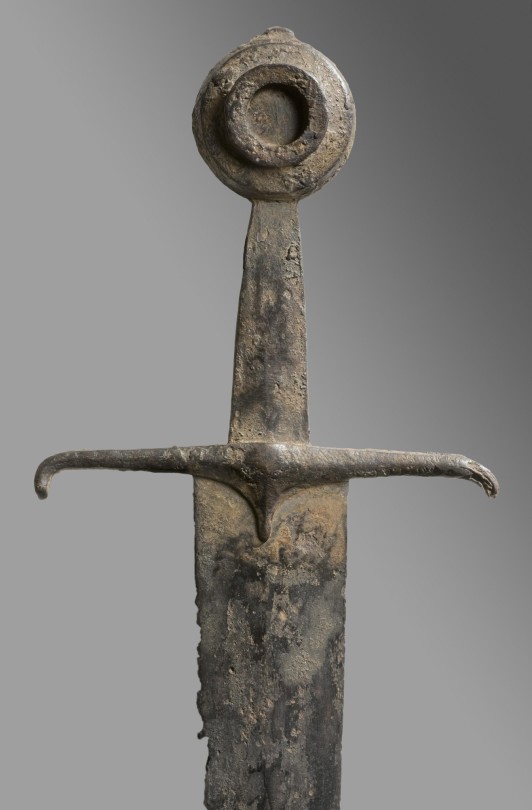
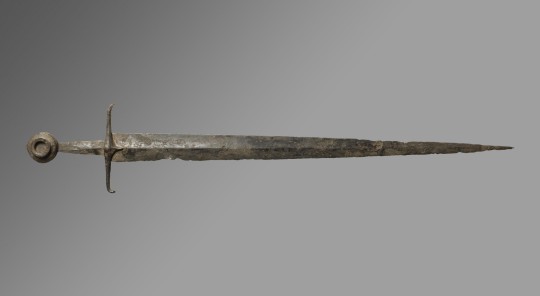
An Arming Sword found near Castillon-la-Bataille,
OaL: 37.9 in/96.2 cm
Weight: 3.3 lbs/1489 g
England or France, ca. 1450, housed at the Philadelphia Museum of Art.
#weapons#sword#arming sword#europe#european#england#english#britain#british#france#french#castillon#medieval#middle ages#phillymuseumofart#art#history
675 notes
·
View notes
Text









9 favorite books I read this year!!! (but I only managed to finish 17 and I'm in college😶🌫️🌟) Lowkey liked lolly willowes better than one of these but the pic wouldn't save💔very good book though
#some are long poems never mind all that#the waste land#all silver and no brass#modernism#folkloristics#poetry#south Asian literature#british literature#russian lit#dykes to watch out for#alison bechdel#mrs dalloway#virginia woolf#rebecca daphne du maurier#medieval history#ardhakathanaka#house of the dead Dostoyevsky#return of the soldier#sylvia townsend warner#lolly willowes#books#book covers#literature#top 9 books
25 notes
·
View notes
Note
Can I request a further rant on Alice Albinia's The Britannias please?
Anonymous asked: 'Further rant available upon request' here is my official request.
Aha. You are both prompt and accommodating. And it is my lunch break, so let's do this!
For context, this is the book in question:
This book was recently published, comes highly reviewed and (as I said) has apparently already been longlisted for some prestigious nonfiction writing/women's prizes. I got it from the library the other day and started reading it; I'm about 150 pages in. It has given me an increasing Itch to the point where lo, yes, here I am on Tumblr about to compose a Statement. This may be because of what the book blurb states upfront as its focus and goals:
Trespassing into the past to understand the present, The Britannias uncovers an enduring and subversive mythology of islands ruled by women. Albinia finds female independence woven through Roman colonial reports and Welsh medieval poetry, Restoration utopias and island folk songs. These neglected epics offer fierce feminist countercurrents to mainstream narratives of British identity and shed new light on women's status in the body politic today.
Okay... well. Basically, she wants to write a history of Britain as focused on its islands, which in itself is a perfectly valid thing to do. As she states in the introduction, focusing on the history of a place through its physically and geographically marginalized locations, its relation to the "mainland," the constructions of power and identity, how one resists and influences the other, is all a very interesting thing to do. It's just how she does it that gives me a twitch. Her clearly stated goal is to find a "hidden women's history" wherein these "fierce feminist countercurrents" are allowed to inform and eventually subvert a totally androcentric and oblivious mainstream British history that has apparently prevailed largely unchallenged ever since antiquity, and where the Male Process of History deliberately destroyed and excluded all female contributions. She is somehow, apparently, the first one to notice this and/or put it together.
Now I'll be honest, the Secret Magical Women trope also gives me a twitch wherever it appears, whether in saccharinely self-important historical or fantasy-historical fiction or in this case, attempted historical nonfiction. Albinia's thesis also seems, essentially, directly lifted from Marion Zimmer Bradley's Mists of Avalon fantasy series in the 1980s: the pagan Celtic/British tribes were egalitarian, proto-democratic, female-led and/or female-centric, and the conquering Romans/Christians/Saxons were all virulently misogynist, masculine, authoritarian, and determined to stamp out this wherever it appeared. I have only gotten up to about the year 1000 (it goes chronologically), so I can't speak to what rationales Albinia comes up with for the later centuries, but let me just say: Hmm. It says a lot about the overall style of this book that I read the first 10 pages and then immediately picked up my phone to check Wikipedia and see if she was a TERF. As far as I can tell, fortunately, she isn't, but it does give me the same binary gender-essentialist vibe (men are from Mars, women are from Venus), and yikes. Basically, there are a lot of things going on here, and all of them are Not Good when it comes to the actual practice and investigation of premodern women's history:
First, while Albinia cites a few research articles (via endnotes) and translations of primary sources (thus far, mostly Roman and early medieval) we know nothing about her qualifications for using these sources, how she is comparing and analyzing them, whether they should in fact be taken at face value, whether anyone else has written on these topics (spoiler alert: yes), or why we are supposed to buy her narrative of this Hidden Female History of Britain. For example: she includes several passages from Roman writers discussing (reported) actions or (reported) mythologies of British women or British female-associated places. These are presented as uncritical and general fact, or something which we should apparently assume was really happening as described, even when she (occasionally, and shallowly) points to the issue of using exterior and non-contemporary male writers from far away. Her analysis also does not touch at all on the potential metatextual or political impulses these Roman male writers might have for presenting a freshly conquered imperial territory as corruptly or unacceptably feminine, and whether this correlated at all to an overall real-world practice or belief. Yes, as far as we can tell, the ancient Celts were in some ways more "feminist" than the Romans, in that Roman public culture was deliberately and exclusively masculine and patriarchal and any civic participation by women in other societies would thus appear as more than usual. But that is a whole can of worms for many reasons, none of which are highlighted or dealt with here. (Like... are we even going to talk about how the "Roman standard" for society was itself re-created by the Renaissance and how that shapes Western historical views, or...?)
As I said above, the book completely brushes aside any of the previous existing scholarship on these topics (done, you know, by actual historians) and presents it as Albinia discovering these issues or formulating these arguments for the first time. She does mention a few other people whose work she relies on or who are informing her hypothesis, but several times thus far, this is from the 1920s or some other clearly outdated argument. Nobody in the field is still treating arguments made in the 1920s as au courant, and while I can't say for certain, it reads as her being more able to access older or public-domain work (since more up-to-date publications require institutional access or paying for copies) and doing the equivalent of the people on Wikipedia who cite the 1911 Catholic Encyclopedia for everything: they can get that text for free, so that's what they refer to. Now obviously, we all support uncovering feminist strands of history, doing feminist history, challenging heteronormative or patriarchal narratives, etc. But also, we support doing it well and making some reference to the complexity of it!!!!
Likewise, Albinia is a white British woman whose previous books are based on her time living and traveling in India and Pakistan (both of which are, uh, previously British colonies). I have not read them, so I can't speak to how she treats it, but there's certainly an element of exoticizing them here, and while she does make passing reference to the British Empire's effect on those places, she does a sort of weird inverse here. She obviously knows about the basic facts of empire and colonization, but there's a notable amount of time dedicated to portraying ancient/Celtic Britain as the helpless victim of constantly brutal Roman colonization (she makes a few very brief and offhand references to cultural miscegenation and how this process unfolded in ways apart from violence, but they are clearly secondary to her main thesis of this as a masculine rape analogy). She is very clear about mourning for this "sacred divine [female] Britain" which was then destroyed by the unrelentingly violent and misogynist forces of Roman (cultural/military) and Christian (religious) colonization, and as I said, that is straight up Marion Zimmer Bradley. I haven't gotten past said first 150 pages, but I'm not terribly confident that her historical analysis improves much in the centuries to follow.
The book does have some bright spots: it's well written, it's engaging, she includes some colorful and interesting sociological vignettes about life on the margins of modern Britain, and there are certainly some things she's mentioned that I would like to look into in more depth. But yet again, this is being presented as an Authoritative or Revelatory History deserving of recognition and prizes, when there are real historians who have done so much of this work and in so much better ways. There is very little nuance to her thesis, no context or analysis or critique provided for her sources (yet again: why are we supposed to take Roman men as an authority on British women and why is she presenting them as obvious empirical fact while critiquing all other elements of their system/society?) and some squicky assumptions around gender and empire that really would need to be drawn out and examined in more detail. The Secret Magical [Pagan] Women Erased In History By Brutal Men gimmick is one that got a lot of traction with Philippa Gregory (sidenote: bookstore websites really need to stop recommending me Philippa Gregory for Women's History Month before I do crimes), and has been exasperatingly hard to eradicate ever since. Just to name one, we need to talk a lot more about the gender politics of medieval Christianity, any of the work done on this topic already, or anything else that would complicate her argument beyond the simplistic black-and-white state in which it currently exists. There are plenty of historians who would like to do that! Why don't you give some of THEM a call?!?!
Anyway. There is probably more I could say (and might), but I will leave it here for now. Thank you for the indulgence, etc.
#silver-dream89#anonymous#ask#history#women in history#ancient history#medieval history#british history
61 notes
·
View notes
Text
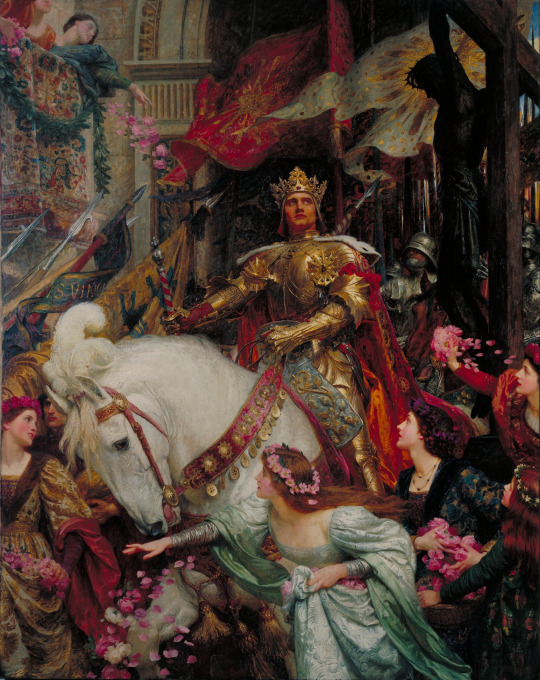
The Two Crowns, Frank Dicksee, 1900
#art#art history#Frank Dicksee#Sir Frank Dicksee#historical painting#Middle Ages#medieval#religious art#Christian art#Christianity#British art#English art#19th century art#Victorian period#Victorian art#oil on canvas#Tate Britain
3K notes
·
View notes
Text

Enid and Geraint by Rowland Wheelwright
#enid#geraint#art#rowland wheelwright#arthurian#romance#romantic#chivalry#chivalric romance#knight#knights#folklore#britain#medieval#middle ages#history#armour#enide#british#europe#european#horses#pathway#forest#wood#woods#woodland#love
4K notes
·
View notes
Text

Iconographic Ring with Two Standing Saints, British, 15th Century
From the Met Museum
46 notes
·
View notes
Text

Elizabeth of York, fashion character design, c. 1481.
#the wars of the roses#15th century#historical#medieval#british history#medieval england#art#illustration#sketch#edward iv#elizabeth woodville#elizabeth of york#henry vii#henry vi#margaret of anjou#margaret beaufort#isabel neville#richard iii#the white queen#the white princess#medieval fashion#historical fashion#character design#artists on tumblr#medieval costume#royals#house of york#plantagenets
475 notes
·
View notes